RBSE Solutions for Class 12 Maths Chapter 1 Relations and Functions Ex 1.2
Rajasthan Board RBSE Solutions for Class 12 Maths Chapter 1 Relations and Functions Ex 1.2 Textbook Exercise Questions and Answers.
Rajasthan Board RBSE Solutions for Class 12 Maths in Hindi Medium & English Medium are part of RBSE Solutions for Class 12. Students can also read RBSE Class 12 Maths Important Questions for exam preparation. Students can also go through RBSE Class 12 Maths Notes to understand and remember the concepts easily.
RBSE Class 12 Maths Solutions Chapter 1 Relations and Functions Ex 1.2
Question 1.
Show that the function f: R* → R* defined by f(x) = \(\frac{1}{x}\) is one-one and onto, where R* is the set of all non-zero real numbers. Is the result true, if the domain R* is replaced by N with co-domain being same as R* ?
Answer:
Given function f(x) = \(\frac{1}{x}\), f:R* → R*
Let x1, x2 ∈ R* (domain)
then f(x1) = f(x2) ⇒ \(\frac{1}{x_{1}}=\frac{1}{x_{2}}\)
⇒ x1 = x2
Thus, function is one one.
Again, if y is an arbitrary element of co-domain.
If f(x) = y, then
y = \(\frac{1}{x}\) ⇒ x = \(\frac{1}{y}\), y ≠ 0
which is an element of domain.
(∀ y ∈ R*, x ∈ R*)
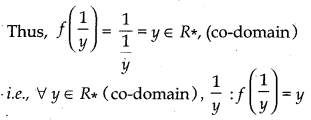
∴ f(R*) = R*
But each element of co-domain is image of one and only one element of domain.
∴ f is onto.
Thus, the given function is one-one and onto.

(ii) When domain R* is replaced by set of natural numbers N and co-domain remains R* then f: N → R*
and f(x) = \(\frac{1}{x}\), where x ∈ N
If x1, x2 ∈ N, then
f(x1) = f(x2) ⇒ \(\frac{1}{x_{1}}=\frac{1}{x_{2}}\)
⇒ x1 = x2, x1, x2 ∈ N
∴ function f is one-one.
Since, domain is set of natural numbers and co-domain is set of non-zero rea1 "ambers, then
f:N → R* and f(x) = \(\frac{1}{x}\)
Let y ∈ R* (co-domain) is any arbitrary element, and f(x) = y
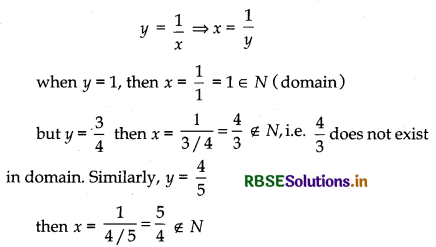
y = \(\frac{1}{x}\) ⇒ x = \(\frac{1}{y}\)
Thus, range of f ⊂R*
Since, some elements of R* are not images of any element of domain.
∴ f is not onto.
So, f is one-one but not onto. Thus, by replacing R* by N result also changes.
Hence Proved.
Question 2.
Check the injectivity and surjectivity of the following functions:
(i) f: N → N given by f(x) = x2
(ii) f: Z → Z given by f(x) = x2
(iii) f:R → R given by f(x) = x2
(iv) f:N → N given by f(x) = x3
(v) f: Z → Z given by f(x) = x3
Answer:
(i) Function f: N → N is given by f(x) = x2
Let x1, x2 ∈ N then
f(x1) = f(x2) ⇒ x12 = x22
⇒ x1 = x2
So, function is (injective).
[x1 = ± x2, x2 cannot be - ve, since x2 ∈ N]
Again, in f(x) = x2 putting x = 1, 2, 3 .......
f(1) = 12 = 1
f(2) = 22 = 4
f(3) = 32 = 9
i.e., There exist some elements in co-domain which are not images of any element of domain. For example, if 5, exist in co-domain, then 5 is not the image of any element of domain. So, f is not onto. (Surjective)
∴ Range of f ⊂ N (co-domain)
∴ f is not onto.
Thus, f is injective but not surjective.

(ii) f: Z → Z, f(x) = x2
Let x1, x2 ∈ Z(domain), then
f(x1) = f(x2)
⇒ x12 = x22 (by definition off)
⇒ (x12 - x22) = 0
⇒ (x1 - x2) (x1 + x2) = 0
⇒ (x1 - x2) = 0 or (x1 + x2) = 0
⇒ x1 = x2 or x1 = - x1
∴ f(x1) = f(x2) ⇒ x1 ≠ x2 (∵ x1 = - x2)
Thus, f is not one-one.
Since x = 1 then f(1) = 12 = 1
then x = - 1 then f(- 1) = (- 1)2 = 1
∴ 1 ≠ - 1 ⇒ f(1) = f(-1) = 1
or f(1) = f(-1) ⇒ 1 ≠ (- 1)
Again, let y ∈ Z (co-domain) is any arbitrary element,
then y = x2 ⇒ x = ± √y (y > 0)
Thus, f is not onto.
Range of f ⊂ Z (co-domain)
∴ f is not onto (Surjective).
Since, in f(x) = x2 putting x = - 1, - 2, - 3, 1, 2, 3
f(1) = 12 = 1, f(- 1) = (- 1)2 = 2,
f(2) = 22 = 4, f(- 2) = (- 2)2 = 4,
f(3) = 32 = 9,
f(- 3) = (-3)2 = 9 etc.
i.e., There exist some elements in co-domain which are not image of any element of domain. For example 7, exist in co-domain but not image of any element of domain. So, f is not onto.
Thus, function is neither injective nor surjective.
(iii) f: R → R is given by f(x) = x3
If 1, - 1 ∈ R, (domain)
Then, f(1) = 12 ⇒ f(-1) = (- 1)2 = 1
Thus, 1 ≠ - 1 ⇒ f(1) = f(- 1)
Here two distinct elements of domain have same image.
∴ Function is not injective.
Again, we see that - 2, 3 are in co-domain but are not the images of any element of domain. Thus, f is not surjective.
∴ f is neither injective nor surjective.

(iv) f: N → N is given by f(x) = x3
If x1, x2 ∈ N domain, then
f(x1) = f(x2) ⇒ x13 = x23,
⇒ x1 = x2
We see that if images of two elements are same, then two elements are same.
Thus, f is injective.
Again, in N, co-domain of function/, there exist many elements which are not image of any one element of domain like 2, 3, 4, 5 etc.
Range of function f = {1, 8, 27, 64,...} ⊂ N
i.e. f(N) ⊂ N
Function is not surjective.
Thus, function is injective but not surjective.
(v) f: Z → Z is given by f(x) = x3
If x1, x2 ∈ Z (domain), then
f(x1) = f(x2) ⇒ x13 = x23
⇒ x1 = x2
Thus, f is injective.
Again, f(1) = 13 = 1, f(-1) = (-1)3 = - 1
f2) = 23 = 8, f(- 2) = (-2)3 = - 8
f(3) = 33 = 27, f(- 3) = (- 3)3 = - 27
f(4) = 43 = 64, f(- 4) = (- 4)3 = - 64
Thus, range of/.
= {..... - 64, - 27, -8, -1, 0,1, 8, 27, 64, ......} ⊂ Z
i.e. f(Z) ⊂ Z (co-domain)
∴ Function f is not surjective.
Thus, function f is injective but not surjective.

Question 3.
Prove that the Greatest Integer Function f:R → R, given by f(x) = [x], is neither one-one nor onto, where [x] denotes the greatest integer less than or equal to x.
Answer:
Given, function f: R → R and f(x) = [x] then,
f(1.4) = 1 and f(1.7) = 1
1.4 ≠ 1.7 ⇒ f(1.4) = f(1.7) = 1
Here, 1.4 and 1.7 both have image 1.
∴ f is not injective.
Since, co-domain of/is set of real numbers R and in the co-domain, all numbers are not integers. But image of x ∈ R (domain) is integer.
∴ The element of co-domain, which is not an integer, is not the image of any element of domain, i.e.,
f(R) ⊂ R (co-domain)
∴ f is not surjective.
Thus, f is neither injective nor surjective.
Hence proved.
Question 4.
Show that the Modulus Function f: R → R, given by f(x) = |x|, is neither one-one nor onto, where |x| is x, if x is positive or 0 and |x| is - x, if x is negative.
Answer:
Here f: R → R and f(x) = |x|, then
f(1) = |1| = 1 and f(- 1) = |- 1| = 1
Here 1 ≠ - 1 ⇒ f(1) = f(- 1) = 1
i.e., Image of two elements 1 and -1 of domain is same as 1.
∴ f is not injective.
f(o) = o
Again f(1) = | 1 | = 1,
f(- 1) = |- 1| = 1
f(2) = |2| = 2,
f(3) = |3|= 3,
f(- 3) = |- 3| = 3
f(4) = |4| = 4,
f(- 4) = |- 4| = 4
Since, there are negative numbers also in co-domain of f but any negative number of co-domain is not the image of any element of domain of f.
∴ f is not surjective.
Thus, function f is neither injective nor surjective.
Hence Proved.

Question 5.
Show that the Signum Function f: R → R, given by

is neither one-one nor onto.
Answer:
Here f: R → R, and

Here, f(1) = 1, f(2) = 1, since 1 > 0, 2 > 0
∴ 1 ≠ 2 ⇒ f(1) = f(2)
i.e., two elements of domain 1 and 2, have same image 1.
Function is not injective.
Since, co-domain of function is set of real numbers and - 1, 0, 1 is only image of elements of domain, then
f(R) = { -1, 0, 1} ⊂ R (Co-domain)
Range of f = {- 1, 0, 1} ⊂ R (Domain)
∴ f is not surjective.
Thus, function f is neither injective nor surjective.
Hence Proved.
Question 6.
Let A = {1, 2, 3}, B = {4, 5, 6, 7} and let f = (1, 4,), (2, 5), (3, 6)} be a function from A to B. Show that f is one-one.
Answer:
According to the questions,
A = {1, 2, 3}, B = {4, 5, 6, 7}
f: A → B is such that
f = {(1, 4), (2, 5), (3, 6)}
Then f(1) = 4, f(2) = 5, f(3) = 6
i.e., Each elements of A has distinct image.
Thus, f is injective.
This can be shown as follows:

Hence Proved.

Question 7.
In each of the following cases, state whether the function is one-one, onto or bijective. Justify your answer.
(i) f: R → R defined by f(x) = 3 - 4x
(ii) f: R → R defined by f(x) = 1 + x2
Answer:
(i) Here, f: R → R and f(x) = 3 - 4x
If x1, x2 ∈ R domain, then
f(x1) = f(x2) ⇒ 3 - 4x1 = 3 - 4x2
⇒ - 4x1 = - 4x2
⇒ x1 = x2
∴ f is injective.
Again, if y is any arbitrary element of co-domain such that f(x) = y
then y = 3 - 4x ⇒ y - 3 = - 4x
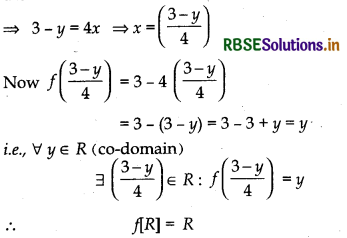
Thus, each element of co-domain is image of any element of domain necessarily.
∴ f is surjective.
Thus, f is one-one and onto.
(ii) f: R → R and f(x) = 1 + x2
Let x1, x2 ∈ R (domain), then,
f(x1) = f(x2) ⇒ 1 + x12 = 1 + x22
⇒ x12 = x22
⇒ (x12 - x22) = 0
⇒ (x1 - x2) (x1 + x2) = 0
⇒ x1 = x2 or x1 = - x2
i.e,, Being images of elements equal, elements are not equal.
Example: f(1) = 1 + 12 = 2
f(- 1) = 1 + (- 1)2
= 1 + 1 = 2
i.e„ 1 ≠ - 1
⇒ f(1) = f(- 1) = 2
∴ f is not injective.
Co-domain of function f has negative numbers also which are not image of any element of domain.
∴ f is not surjective.
Let y ∈ R (co-domain), then
f(x) = y = 1 + x2
⇒ x2 = y - 1
then x = ± √y - 1
If y = 0, then x = ± √-1 ∉ R
So, f is not surjective.
Thus, function f is neither injective nor surjective.

Question 8.
Let A and B be sets. Show that f: A × B → B × A such that f(a, b) = (b, a) is bijective function.
Answer:
According to question,
f: A × B → B × A if f(a, b) = (b, a)
Let (a1, b1) and (a2, b2) ∈ A × B, then
f(a1, b1) = f(a2, b2)
⇒ (b1, a1) = (b2, a2)
⇒ b1 = b2 , a1 = a2
⇒ (b1, a1) = (b2, a2)
Thus, f(a1, b1) = f(a2, b2)
⇒ (b1, a1) = (b2, a2)
where (a1, b1), (a2, b2) ∈ A × B
∴ Function f is injective.
Again, let (b, a) be an arbitrary element of set B × A, then (F, a) ∈ B × A.
⇒ b ∈ B and a ∈ A
⇒ a ∈ A and b ∈ B
⇒ (a, b) ∈ A × B
Thus, ∀ (b, a) ∈ B × A ∃ (a, b) ∈ A × B is such that
f(a, b) = {a, b)
∴ f: A × B → B × A is surjective.
Thus, given function is bijective function.
Hence Proved.
Question 9.
Let f: N → N be defined by

for all n ∈ N. State whether the function f is bijective. Justify your answer.
Answer:
f: N → N and
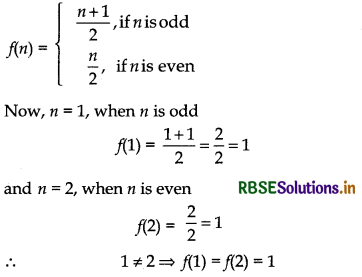
i.e., Image of two distinct elements 1 and 2 is same as element 2.
Thus, function is not one-one, i.e., function is many-one. Let n be any arbitrary constant of set N, i.e., n ∈ N.
If n is odd then (2n - 1) will also be odd, then
f(2n - 1) = \(\frac{(2 n-1)+1}{2}\) = \(\frac{2 n}{2}\) = n
f(n) = \(\frac{(n-1)}{2}\), when n is odd
and when n is even then 2n will also be even.
Thus, f(2n) = \(\frac{2 n}{2}\) = n [∵ f(n) = \(\frac{n}{2}\), when n os even]
Thus, we see that either n is even or odd.
Then f(N) = N
∴ f is surjective.
Thus, given function is many-one onto but not one-one onto.

Question 10.
Let A = R - {3} and B = R - {1}. Consider the function f: A → B defined by f(x) = \(\left(\frac{x-2}{x-3}\right)\). Is f one-one and onto ? Justify your answer.
Answer:
According to the question,
A = R - {3} and B = R - {1} and f: A → B, then
f(x) = \(\frac{x-2}{x-3}\)
Let x1, x2 ∈ A, then
Let f(x1) = f(x2) ⇒ \(\frac{x_{1}-2}{x_{1}-3}=\frac{x_{2}-2}{x_{1}-3}\)
⇒ (x1 - 2) (x2 - 3) = (x2 - 2) (x1 - 3)
⇒ x1x2 - 3x1 - 2x2 + 6 = x1x2 - 3x2 - 2x1 + 6
⇒ 3x2 - 2x2 = 3x1 - 2x1
⇒ x2 = x1
⇒ x1 = x2
∴ Function f is one-one.
Again, let y ∈ B be any arbitrary elements such that
y = f(x)
y = \(\left(\frac{x-2}{x-3}, x \neq 3\right)\)
then (x - 3) y = x - 2
⇒ xy - 3y = x - 2
⇒ xy - x = 3y -2
⇒ x(y - 1) = 3y - 2
∴ x = \(\frac{3 y-2}{y-1}\)
Clearly, x is not defined for y ≠ 1.
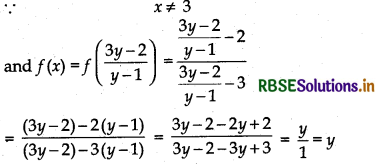
Thus, ∀ y ∈ B, ∃ x ∈ A: f(x) = y
∴ Function f is onto.
Thus, given function f is one-one onto.
Question 11.
Let f: R → R be defined as f(x) = x4. Choose the correct answer:
(A) f is one-one onto
(B) f is many-one onto
(C) f is one-one but not onto
(D) f is neither one-one nor onto
Answer:
According to the question,
f:R → R, f(x) = x4
Let x1, x2 ∈ R (domain)
∴ f(x1) = f(x2)
⇒ x14 = x24
⇒ x14 - x24 = 0
⇒ (x12 - x22) (x12 + x22) = 0
But x12 + x12 ≠ 0, since sum of squares of two real numbers cannot be zero.
∴ x12 - x22 = 0
⇒ (x1 - x2) (x1 + x2) = 0
⇒ x1 - x2 = 0 or x1 + x2 = 0
⇒ x1 = x2 or x1 = - x2
f(x1) = f(x2) ⇒ x1 ≠ x2,
Thus, f is not one-one.
Since, x = 1 for, f(1) = 14 = 1
and x = - 1 for, f(- 1) = (- 1)4 = 1
and x = 2 for f(2) = 24 = 16
and x = - 2 for, f(- 2) = (- 2)4 = 16
i.e., f(1) = f(-1) and f(2) = f(- 2)
∴ 1 ≠ - 1 ⇒ f(1) = f(- 1) = 1
and 2 ≠ - 2 ⇒ f(2) = f(- 2) = 16
For onto, let y ∈ R (co-domain) be any arbitrary element.
and f(x) = y
then , y = x4 ⇒ x = (y)1/4, y ≥ 0
∵ There are negative numbers also in co-domain. Thus, any negative number (of co-domain) is not the image of any element of domain. For example, element - 2 of co-domain is not the image of any element of domain. In other words, range of f is set of non-negative numbers, i.e.,
Range of f ⊂ R (co-domain)
So, function is not onto.
Thus, given function is neither one-one nor onto and so, (D) is correct.

Question 12.
Let f: R → R be defined as f(x) = 3x. Choose the correct answer:
(A) f is one-one onto
(B) f is many-one onto
(C) f is one-one but not onto
(D) f is neither one-one nor onto
Answer:
According to the question,
f: R → R, if f(x) = 3x .
Let x1, x2 ∈ R (domain)
Then f(x1) = f(x2) ⇒ 3x1 = 3x2
⇒ x1 = x2
Thus, f is one-one.
Let y ∈ R co-domain be any arbitrary element such that y = f(x), then
y = f(x) ⇒ y = 3x
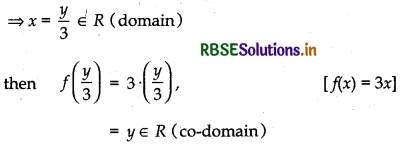
Thus, image of \(\frac{y}{3}\) element of domain R is element y of co-domain.
∴ f is onto
So, function is one-one onto.
Thus, (A) is correct.

- RBSE Class 12 Maths Notes Chapter 13 Probability
- RBSE Class 12 Maths Notes Chapter 12 Linear Programming
- RBSE Class 12 Maths Notes Chapter 11 Three Dimensional Geometry
- RBSE Class 12 Maths Notes Chapter 10 Vector Algebra
- RBSE Class 12 Maths Notes Chapter 9 Differential Equations
- RBSE Class 12 Maths Notes Chapter 8 Application of Integrals
- RBSE Class 12 Maths Notes Chapter 7 Integrals
- RBSE Class 12 Maths Notes Chapter 6 Application of Derivatives
- RBSE Class 12 Maths Notes Chapter 5 Continuity and Differentiability
- RBSE Class 12 Maths Notes Chapter 4 Determinants
- RBSE Class 12 Maths Notes Chapter 3 Matrices